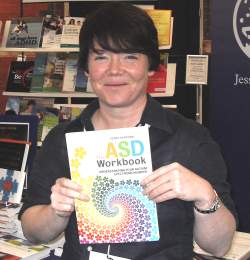 Penny Kershaw is the autism manager and outreach service leader for a special school in East Sussex, UK. In addition, she provides training and support to staff, pupils with ASDs and their families in other mainstream and special schools in the locality.
Penny Kershaw is the autism manager and outreach service leader for a special school in East Sussex, UK. In addition, she provides training and support to staff, pupils with ASDs and their families in other mainstream and special schools in the locality.
Here, she answers some questions about her new book, The ASD Workbook: Understanding Your Autism Spectrum Disorder.
How did you come to work with students with ASDs and their families?
I have been fascinated by autism for many years. A school friend lent me a copy of the Oliver Sacks’ book, The Man Who Mistook His Wife For a Hat, which sparked a life long interest in autism as well as the neurological diversity that can occur amongst people. Very soon after working in autism specific educational settings, it became apparent that families of children with autism and professionals benefit hugely from sharing ideas and working in partnership.
The highlight of my day is making a direct ‘connection’ with pupils; their smiles and laughter are irreplaceable. It is also heart warming when parents feedback about a strategy or idea that has been successful at home, like being able to go to the shops or to share an activity with a sibling for the first time.
Tell us about the book – how did the book come about, and who is it for?
The book was written in response to working with families who often encountered difficulties with their autistic children; these difficulties often arose from misunderstanding each other’s needs or points of view. Parents would often say, ‘Why does my son get angry when his little brother just wants to touch his Lego?’ or ‘I wish my daughter would tell me how her day was at school because I worry that she might not be happy.’ Some of my pupils would also inform me of a list of things that they didn’t think they could ever do ‘because they have autism’.
The book is aimed at higher functioning children/adolescents with autism and is designed to act as a framework for developing a shared understanding of autism for the parents and for the individual with autism. The book begins by introducing autism in a positive and proactive way and includes many practical activities for example a chapter about developing friendships and relationships.
What do parents find most difficult in introducing an ASD diagnosis to their child? How can your book help?
I think that there are two main difficulties. Firstly, finding the right time and place to introduce the diagnosis to their child seems difficult, and secondly feeling apprehensive about how to present the diagnosis in an accurate and positive manner. Parents may also need some time to learn more about what the diagnosis means and it can be difficult to explain this to their friends and families. In the book there is a checklist about introducing ASDs to help guide parents through the process.
What are some of the most important things that young people with ASDs will learn about themselves from your book?
I hope that young people reading this book will learn that autism is primarily a difference and not necessarily always a disorder; there are many positive sides to the autistic thinking style. A diagnosis of autism should enable the young person to develop their awareness both of themselves and others, which should help relationships to develop. Throughout the book, I have tried to explain why neuro-typicals behave in a certain way that should alleviate any anxiety or frustration that the young person may experience.
How does this book constitute a ‘record of development’, and how can this benefit young people and their families?
The book is designed so that young people and their families can look back on completed pages and see how skills and understanding have developed over time. Some areas in the book, for example the information on friends can be referred back to at any time e.g. when friends become girlfriends. The completed book could be used as a reference throughout adolescence as it will develop into a personalised guide about autism, specific to the individual’s circumstances.
Copyright © Jessica Kingsley Publishers 2011.